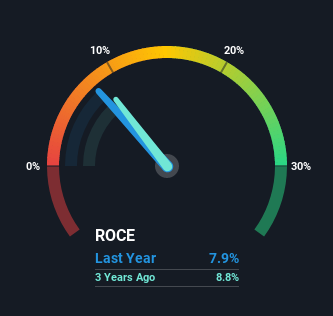- United States
- /
- Transportation
- /
- NasdaqGS:HTLD
Here's What's Concerning About Heartland Express' (NASDAQ:HTLD) Returns On Capital

If we want to find a stock that could multiply over the long term, what are the underlying trends we should look for? In a perfect world, we'd like to see a company investing more capital into its business and ideally the returns earned from that capital are also increasing. Put simply, these types of businesses are compounding machines, meaning they are continually reinvesting their earnings at ever-higher rates of return. In light of that, when we looked at Heartland Express (NASDAQ:HTLD) and its ROCE trend, we weren't exactly thrilled.
Return On Capital Employed (ROCE): What is it?
Just to clarify if you're unsure, ROCE is a metric for evaluating how much pre-tax income (in percentage terms) a company earns on the capital invested in its business. The formula for this calculation on Heartland Express is:
Return on Capital Employed = Earnings Before Interest and Tax (EBIT) ÷ (Total Assets - Current Liabilities)
0.079 = US$68m ÷ (US$929m - US$72m) (Based on the trailing twelve months to December 2021).
Thus, Heartland Express has an ROCE of 7.9%. In absolute terms, that's a low return and it also under-performs the Transportation industry average of 12%.
See our latest analysis for Heartland Express

Above you can see how the current ROCE for Heartland Express compares to its prior returns on capital, but there's only so much you can tell from the past. If you're interested, you can view the analysts predictions in our free report on analyst forecasts for the company.
What The Trend Of ROCE Can Tell Us
When we looked at the ROCE trend at Heartland Express, we didn't gain much confidence. Around five years ago the returns on capital were 11%, but since then they've fallen to 7.9%. On the other hand, the company has been employing more capital without a corresponding improvement in sales in the last year, which could suggest these investments are longer term plays. It may take some time before the company starts to see any change in earnings from these investments.
The Bottom Line On Heartland Express' ROCE
Bringing it all together, while we're somewhat encouraged by Heartland Express' reinvestment in its own business, we're aware that returns are shrinking. Since the stock has declined 25% over the last five years, investors may not be too optimistic on this trend improving either. On the whole, we aren't too inspired by the underlying trends and we think there may be better chances of finding a multi-bagger elsewhere.
Heartland Express does have some risks, we noticed 2 warning signs (and 1 which can't be ignored) we think you should know about.
While Heartland Express may not currently earn the highest returns, we've compiled a list of companies that currently earn more than 25% return on equity. Check out this free list here.
Valuation is complex, but we're here to simplify it.
Discover if Heartland Express might be undervalued or overvalued with our detailed analysis, featuring fair value estimates, potential risks, dividends, insider trades, and its financial condition.
Access Free AnalysisHave feedback on this article? Concerned about the content? Get in touch with us directly. Alternatively, email editorial-team (at) simplywallst.com.
This article by Simply Wall St is general in nature. We provide commentary based on historical data and analyst forecasts only using an unbiased methodology and our articles are not intended to be financial advice. It does not constitute a recommendation to buy or sell any stock, and does not take account of your objectives, or your financial situation. We aim to bring you long-term focused analysis driven by fundamental data. Note that our analysis may not factor in the latest price-sensitive company announcements or qualitative material. Simply Wall St has no position in any stocks mentioned.
About NasdaqGS:HTLD
Heartland Express
Operates as a short-to-medium, and long-haul truckload carrier in the United States and Canada.
Fair value with moderate growth potential.
Market Insights
Community Narratives



